engine Alfa Romeo 159 2008 Owner handbook (in English)
[x] Cancel search | Manufacturer: ALFA ROMEO, Model Year: 2008, Model line: 159, Model: Alfa Romeo 159 2008Pages: 303, PDF Size: 5.18 MB
Page 64 of 303
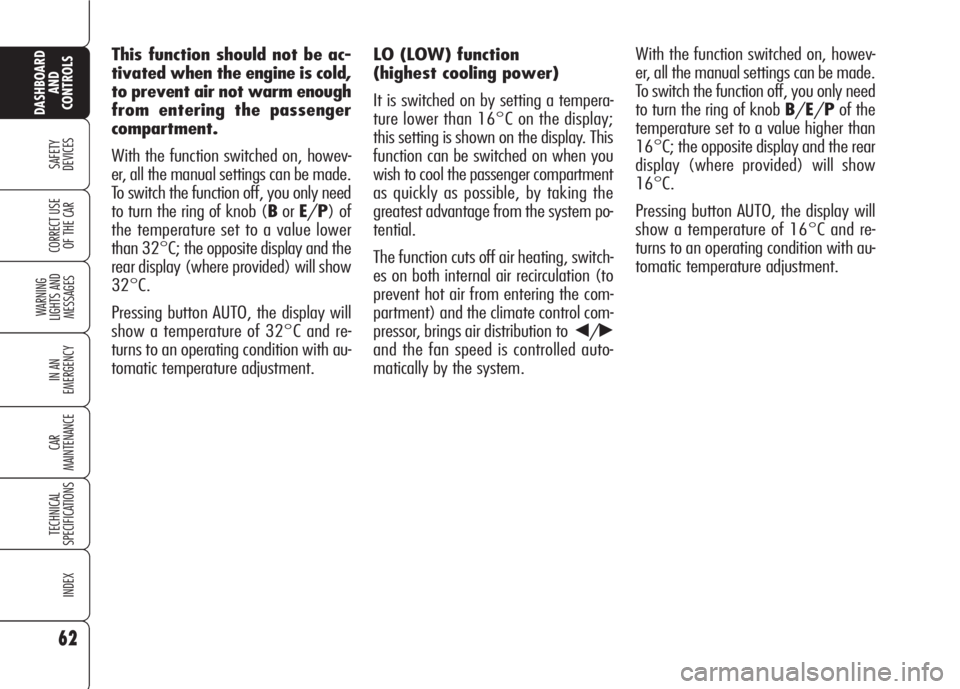
62
SAFETY
DEVICES
WARNING
LIGHTS AND
MESSAGES
IN AN
EMERGENCY
CAR
MAINTENANCE
TECHNICAL
SPECIFICATIONS
INDEX
CORRECT USE
OF THE CAR
DASHBOARD
AND
CONTROLS
LO (LOW) function
(highest cooling power)
It is switched on by setting a tempera-
ture lower than 16°C on the display;
this setting is shown on the display. This
function can be switched on when you
wish to cool the passenger compartment
as quickly as possible, by taking the
greatest advantage from the system po-
tential.
The function cuts off air heating, switch-
es on both internal air recirculation (to
prevent hot air from entering the com-
partment) and the climate control com-
pressor, brings air distribution to
¯/˙
and the fan speed is controlled auto-
matically by the system. With the function switched on, howev-
er, all the manual settings can be made.
To switch the function off, you only need
to turn the ring of knob B/E/Pof the
temperature set to a value higher than
16°C; the opposite display and the rear
display (where provided) will show
16°C.
Pressing button AUTO, the display will
show a temperature of 16°C and re-
turns to an operating condition with au-
tomatic temperature adjustment. This function should not be ac-
tivated when the engine is cold,
to prevent air not warm enough
from entering the passenger
compartment.
With the function switched on, howev-
er, all the manual settings can be made.
To switch the function off, you only need
to turn the ring of knob (BorE/P) of
the temperature set to a value lower
than 32°C; the opposite display and the
rear display (where provided) will show
32°C.
Pressing button AUTO, the display will
show a temperature of 32°C and re-
turns to an operating condition with au-
tomatic temperature adjustment.
Page 65 of 303

63
SAFETY
DEVICES
WARNING
LIGHTS AND
MESSAGES
IN AN
EMERGENCY
CAR
MAINTENANCE
TECHNICAL
SPECIFICATIONS
INDEX
CORRECT USE
OF THE CAR
DASHBOARD
AND
CONTROLS
FAN SPEED ADJUSTMENT
Press buttons +/–to increase or to de-
crease the fan speed.
The fan speed is shown by the lit bars on
the display:
❒min fan speed = one bar lit;
❒max fan speed = 6 bars lit;
At starting, if climate control system is
operating in automatic mode, the fan
speed is kept at minimum until the en-
gine has started.
With compressor on and engine running,
the fan speed cannot fall below the min.
speed.
The fan can be cut off (all bars off) on-
ly if the climate control compressor has
been switched off by pressing button
√.
To restore automatic fan speed control
after a manual adjustment, press but-
tons AUTO. AUTO will also go off if the system (spe-
cially when compressor is turned off
manually) cannot reach or cannot keep
the required temperature.
Button
√will not turn off AUTO if the
system can keep the required comfort.
It is inadvisable to use
air recirculation on
rainy/cold days as it would
considerably increase the pos-
sibility of windows misting up
inside.
WARNING
AUTOMATIC OPERATION
(AUTO BUTTON)
Pressing button AUTO (front and rear
controls) the displays will show FULL AU-
TO and the system will automatically ad-
just:
❒fan speed;
❒air distribution in passenger com-
partment;
❒air recirculation;
❒compressor;
and it will cancel all the previous man-
ual adjustments.
Wording FULL will disappear from the
display of the involved area (driver or
front passenger side or rear passenger
side) when performing whatever oper-
ation (excluding temperature change).
Page 66 of 303

64
SAFETY
DEVICES
WARNING
LIGHTS AND
MESSAGES
IN AN
EMERGENCY
CAR
MAINTENANCE
TECHNICAL
SPECIFICATIONS
INDEX
CORRECT USE
OF THE CAR
DASHBOARD
AND
CONTROLS
The MAX-DEF function activates the fol-
lowing operations:
❒rear panel turning off;
❒air flow increase;
❒air distribution at DEF;
❒outside air intake;
❒compressor activation;
❒AQS function deactivation (where
provided)
❒rear window heating activation.
When the MAX-DEF function is on, the
only manual operations possible are
manual adjustment of the fan speed and
switching heated rear window off.IMPORTANTIf the engine is not
warm enough, the function will not en-
gage the predefined fan speed imme-
diately, to limit the flow to the passen-
ger compartment of air that is not warm
enough to demist the windows.
Pressing again one of the following but-
tons:
v,√, AUTO, MONO or -the
system switches off the MAX-DEF func-
tion, resuming the system operating con-
ditions prior to turning it on, in addition
to activating the last function required,
if any.
IMPORTANT Don’t turn the MAX-DEF
function on with engine off to prevent
draining the battery.
QUICK FRONT WINDOW
DEMISTING/DEFROSTING
(MAX-DEF function)
Pressing button -the climate control
automatically activates timed operation
of all the functions required to quicken
demisting/defrosting of the windscreen
and front side windows and, on certain
versions, electric windscreen demisting
in the windscreen wiper area.
The MAX-DEF can be turned on also with
engine off. When this function is on the
circular led around the button will turn on.
Page 67 of 303

65
SAFETY
DEVICES
WARNING
LIGHTS AND
MESSAGES
IN AN
EMERGENCY
CAR
MAINTENANCE
TECHNICAL
SPECIFICATIONS
INDEX
CORRECT USE
OF THE CAR
DASHBOARD
AND
CONTROLS
ALIGNING SET
TEMPERATURES
(MONO function)
Pressing button MONO automatically
aligns the temperature and air distribu-
tion on front and rear passenger area
with that on the driver area.
When this function is on, the circular led
around the button will turn on.
Turn knob Bto set the same tempera-
ture between the two/three zones.
Separate operation of set temperatures
(front and rear passengers) is restored
automatically by turning knob EorPor
by pressing again button MONO, the cir-
cular led around the button will turn off.
IMPORTANTOperating the rear con-
trols (Three-zone configuration) will turn
off the MONO function and the relevant
circular led around the MONO button.
CLIMATE CONTROL
COMPRESSOR ON/OFF
Press button √to turn the compressor
on: when climate control compressor is
on the circular led around the button will
turn on. Compressor will stay on also af-
ter turning the engine off.
To turn the compressor off press again
button
√.
HEATED REAR WINDOW
AND DOOR MIRROR
DEMISTING/DEFROSTING
Press button (to activate the demist-
ing/defrosting function: when this func-
tion is on, the circular led around the but-
ton will turn on.
On certain versions, turning this function
on will also activate windscreen de-
frosting in the windscreen wiper area.
This function is timed and switches off
automatically after few minutes, or by
pressing again the button or by turning
the engine off. It will not be switched
on automatically when restarting the en-
gine.
IMPORTANT Do not apply stickers on
the inside of the rear window over the
heating filaments to avoid damage that
might cause it to stop working properly.
Page 71 of 303
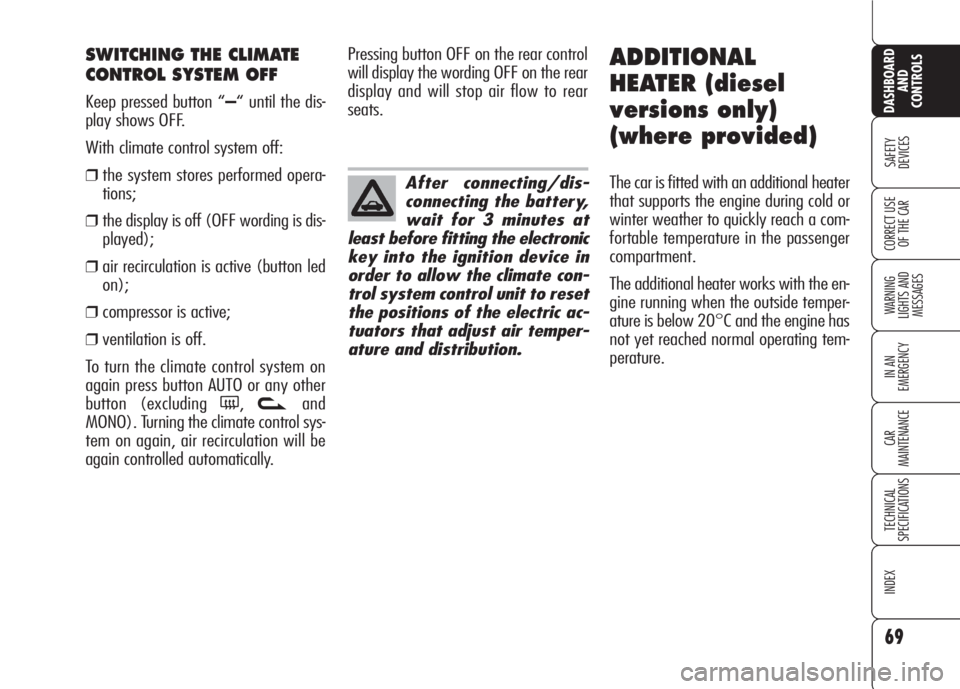
69
SAFETY
DEVICES
WARNING
LIGHTS AND
MESSAGES
IN AN
EMERGENCY
CAR
MAINTENANCE
TECHNICAL
SPECIFICATIONS
INDEX
CORRECT USE
OF THE CAR
DASHBOARD
AND
CONTROLS
SWITCHING THE CLIMATE
CONTROL SYSTEM OFF
Keep pressed button “–“ until the dis-
play shows OFF.
With climate control system off:
❒the system stores performed opera-
tions;
❒the display is off (OFF wording is dis-
played);
❒air recirculation is active (button led
on);
❒compressor is active;
❒ventilation is off.
To turn the climate control system on
again press button AUTO or any other
button (excluding
(,vand
MONO). Turning the climate control sys-
tem on again, air recirculation will be
again controlled automatically.Pressing button OFF on the rear control
will display the wording OFF on the rear
display and will stop air flow to rear
seats.
ADDITIONAL
HEATER (diesel
versions only)
(where provided)
The car is fitted with an additional heater
that supports the engine during cold or
winter weather to quickly reach a com-
fortable temperature in the passenger
compartment.
The additional heater works with the en-
gine running when the outside temper-
ature is below 20°C and the engine has
not yet reached normal operating tem-
perature. After connecting/dis-
connecting the battery,
wait for 3 minutes at
least before fitting the electronic
key into the ignition device in
order to allow the climate con-
trol system control unit to reset
the positions of the electric ac-
tuators that adjust air temper-
ature and distribution.
Page 73 of 303
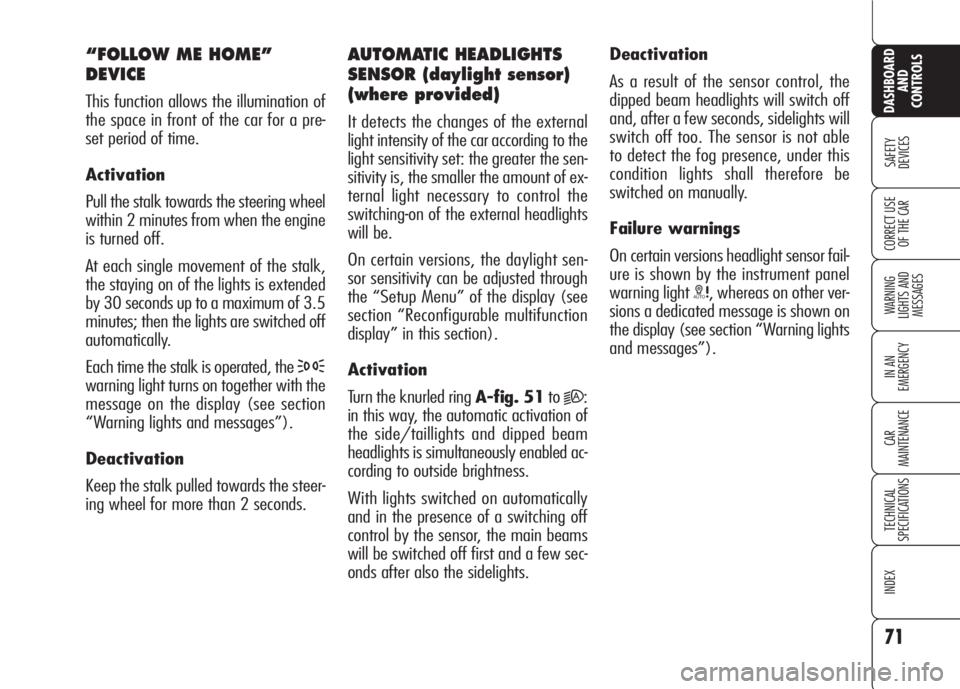
71
SAFETY
DEVICES
WARNING
LIGHTS AND
MESSAGES
IN AN
EMERGENCY
CAR
MAINTENANCE
TECHNICAL
SPECIFICATIONS
INDEX
CORRECT USE
OF THE CAR
DASHBOARD
AND
CONTROLS
“FOLLOW ME HOME”
DEVICE
This function allows the illumination of
the space in front of the car for a pre-
set period of time.
Activation
Pull the stalk towards the steering wheel
within 2 minutes from when the engine
is turned off.
At each single movement of the stalk,
the staying on of the lights is extended
by 30 seconds up to a maximum of 3.5
minutes; then the lights are switched off
automatically.
Each time the stalk is operated, the
3
warning light turns on together with the
message on the display (see section
“Warning lights and messages”).
Deactivation
Keep the stalk pulled towards the steer-
ing wheel for more than 2 seconds.
AUTOMATIC HEADLIGHTS
SENSOR (daylight sensor)
(where provided)
It detects the changes of the external
light intensity of the car according to the
light sensitivity set: the greater the sen-
sitivity is, the smaller the amount of ex-
ternal light necessary to control the
switching-on of the external headlights
will be.
On certain versions, the daylight sen-
sor sensitivity can be adjusted through
the “Setup Menu” of the display (see
section “Reconfigurable multifunction
display” in this section).
Activation
Turn the knurled ring A-fig. 51to
2A:
in this way, the automatic activation of
the side/taillights and dipped beam
headlights is simultaneously enabled ac-
cording to outside brightness.
With lights switched on automatically
and in the presence of a switching off
control by the sensor, the main beams
will be switched off first and a few sec-
onds after also the sidelights.Deactivation
As a result of the sensor control, the
dipped beam headlights will switch off
and, after a few seconds, sidelights will
switch off too. The sensor is not able
to detect the fog presence, under this
condition lights shall therefore be
switched on manually.
Failure warnings
On certain versions headlight sensor fail-
ure is shown by the instrument panel
warning light
1, whereas on other ver-
sions a dedicated message is shown on
the display (see section “Warning lights
and messages”).
Page 74 of 303
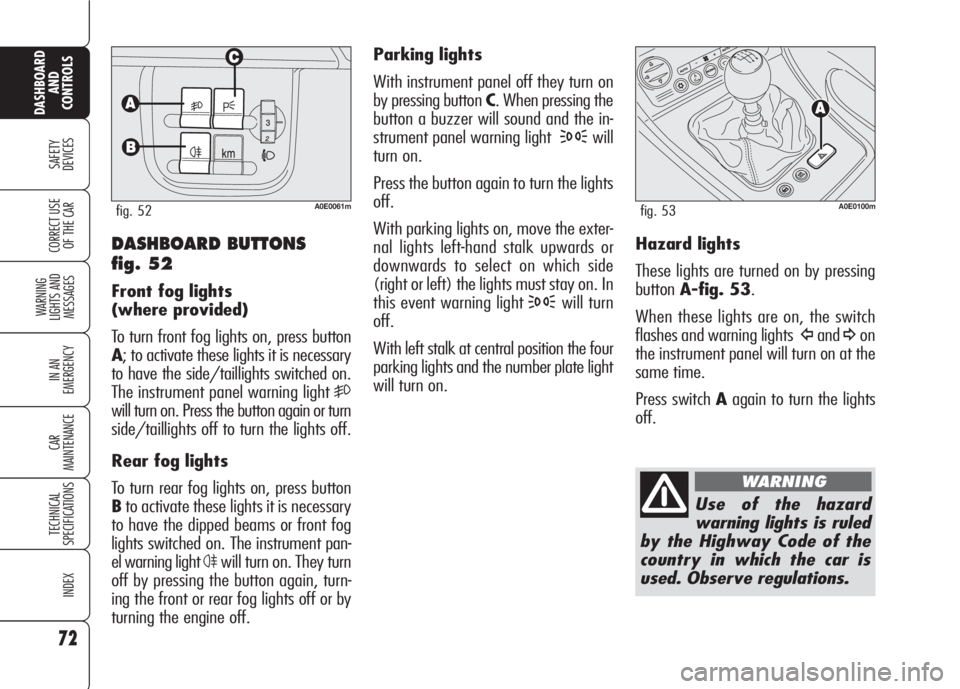
72
SAFETY
DEVICES
WARNING
LIGHTS AND
MESSAGES
IN AN
EMERGENCY
CAR
MAINTENANCE
TECHNICAL
SPECIFICATIONS
INDEX
CORRECT USE
OF THE CAR
DASHBOARD
AND
CONTROLS
Parking lights
With instrument panel off they turn on
by pressing button C. When pressing the
button a buzzer will sound and the in-
strument panel warning light
3will
turn on.
Press the button again to turn the lights
off.
With parking lights on, move the exter-
nal lights left-hand stalk upwards or
downwards to select on which side
(right or left) the lights must stay on. In
this event warning light
3will turn
off.
With left stalk at central position the four
parking lights and the number plate light
will turn on.
DASHBOARD BUTTONS
fig. 52
Front fog lights
(where provided)
To turn front fog lights on, press button
A; to activate these lights it is necessary
to have the side/taillights switched on.
The instrument panel warning light
5
will turn on. Press the button again or turn
side/taillights off to turn the lights off.
Rear fog lights
To turn rear fog lights on, press button
Bto activate these lights it is necessary
to have the dipped beams or front fog
lights switched on. The instrument pan-
el warning light
4will turn on. They turn
off by pressing the button again, turn-
ing the front or rear fog lights off or by
turning the engine off.
A0E0061mfig. 52
Hazard lights
These lights are turned on by pressing
buttonA-fig. 53.
When these lights are on, the switch
flashes and warning lights
Îand¥on
the instrument panel will turn on at the
same time.
Press switch Aagain to turn the lights
off.
Use of the hazard
warning lights is ruled
by the Highway Code of the
country in which the car is
used. Observe regulations.
WARNING
A0E0100mfig. 53
Page 76 of 303
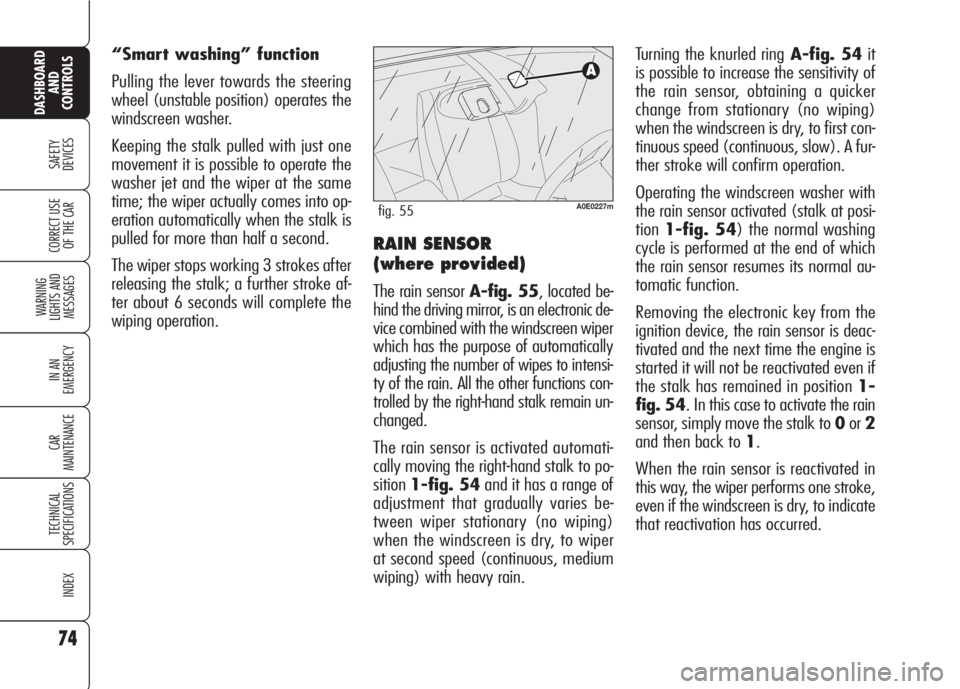
74
SAFETY
DEVICES
WARNING
LIGHTS AND
MESSAGES
IN AN
EMERGENCY
CAR
MAINTENANCE
TECHNICAL
SPECIFICATIONS
INDEX
CORRECT USE
OF THE CAR
DASHBOARD
AND
CONTROLS
Turning the knurled ringA-fig. 54it
is possible to increase the sensitivity of
the rain sensor, obtaining a quicker
change from stationary (no wiping)
when the windscreen is dry, to first con-
tinuous speed (continuous, slow). A fur-
ther stroke will confirm operation.
Operating the windscreen washer with
the rain sensor activated (stalk at posi-
tion1-fig. 54) the normal washing
cycle is performed at the end of which
the rain sensor resumes its normal au-
tomatic function.
Removing the electronic key from the
ignition device, the rain sensor is deac-
tivated and the next time the engine is
started it will not be reactivated even if
the stalk has remained in position 1-
fig. 54. In this case to activate the rain
sensor, simply move the stalk to 0or2
and then back to 1.
When the rain sensor is reactivated in
this way, the wiper performs one stroke,
even if the windscreen is dry, to indicate
that reactivation has occurred. “Smart washing” function
Pulling the lever towards the steering
wheel (unstable position) operates the
windscreen washer.
Keeping the stalk pulled with just one
movement it is possible to operate the
washer jet and the wiper at the same
time; the wiper actually comes into op-
eration automatically when the stalk is
pulled for more than half a second.
The wiper stops working 3 strokes after
releasing the stalk; a further stroke af-
ter about 6 seconds will complete the
wiping operation.
RAIN SENSOR
(where provided)
The rain sensor A-fig. 55, located be-
hind the driving mirror, is an electronic de-
vice combined with the windscreen wiper
which has the purpose of automatically
adjusting the number of wipes to intensi-
ty of the rain. All the other functions con-
trolled by the right-hand stalk remain un-
changed.
The rain sensor is activated automati-
cally moving the right-hand stalk to po-
sition1-fig. 54and it has a range of
adjustment that gradually varies be-
tween wiper stationary (no wiping)
when the windscreen is dry, to wiper
at second speed (continuous, medium
wiping) with heavy rain.
A0E0227mfig. 55
Page 79 of 303
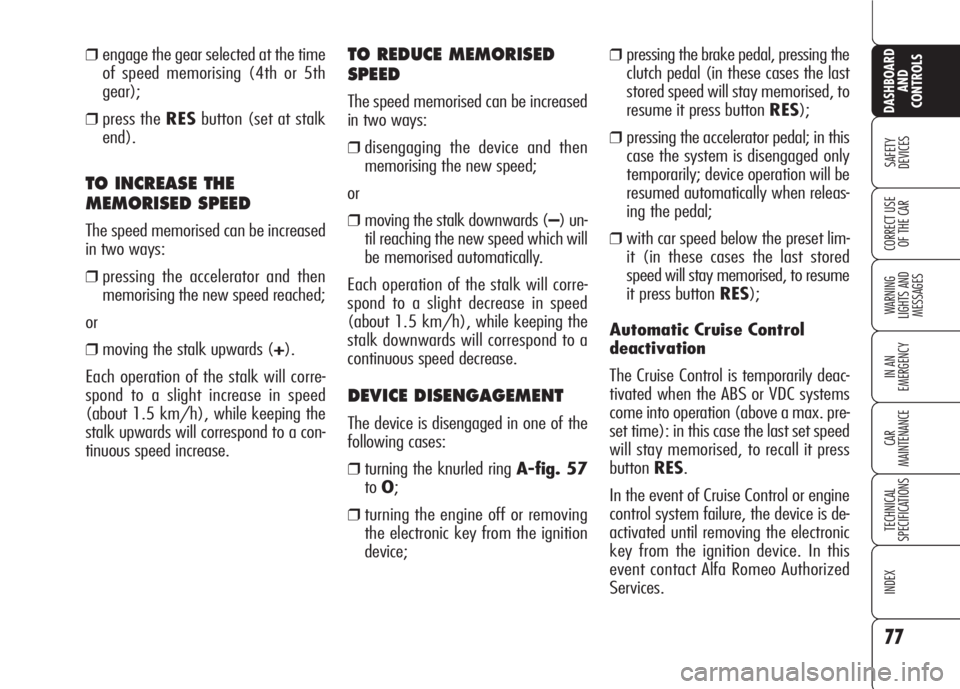
77
SAFETY
DEVICES
WARNING
LIGHTS AND
MESSAGES
IN AN
EMERGENCY
CAR
MAINTENANCE
TECHNICAL
SPECIFICATIONS
INDEX
CORRECT USE
OF THE CAR
DASHBOARD
AND
CONTROLS
❒pressing the brake pedal, pressing the
clutch pedal (in these cases the last
stored speed will stay memorised, to
resume it press button RES);
❒pressing the accelerator pedal; in this
case the system is disengaged only
temporarily; device operation will be
resumed automatically when releas-
ing the pedal;
❒with car speed below the preset lim-
it (in these cases the last stored
speed will stay memorised, to resume
it press button RES);
Automatic Cruise Control
deactivation
The Cruise Control is temporarily deac-
tivated when the ABS or VDC systems
come into operation (above a max. pre-
set time): in this case the last set speed
will stay memorised, to recall it press
buttonRES.
In the event of Cruise Control or engine
control system failure, the device is de-
activated until removing the electronic
key from the ignition device. In this
event contact Alfa Romeo Authorized
Services.
❒engage the gear selected at the time
of speed memorising (4th or 5th
gear);
❒press the RESbutton (set at stalk
end).
TO INCREASE THE
MEMORISED SPEED
The speed memorised can be increased
in two ways:
❒pressing the accelerator and then
memorising the new speed reached;
or
❒moving the stalk upwards (+).
Each operation of the stalk will corre-
spond to a slight increase in speed
(about 1.5 km/h), while keeping the
stalk upwards will correspond to a con-
tinuous speed increase.
TO REDUCE MEMORISED
SPEED
The speed memorised can be increased
in two ways:
❒disengaging the device and then
memorising the new speed;
or
❒moving the stalk downwards (–) un-
til reaching the new speed which will
be memorised automatically.
Each operation of the stalk will corre-
spond to a slight decrease in speed
(about 1.5 km/h), while keeping the
stalk downwards will correspond to a
continuous speed decrease.
DEVICE DISENGAGEMENT
The device is disengaged in one of the
following cases:
❒turning the knurled ring A-fig. 57
toO;
❒turning the engine off or removing
the electronic key from the ignition
device;
Page 81 of 303
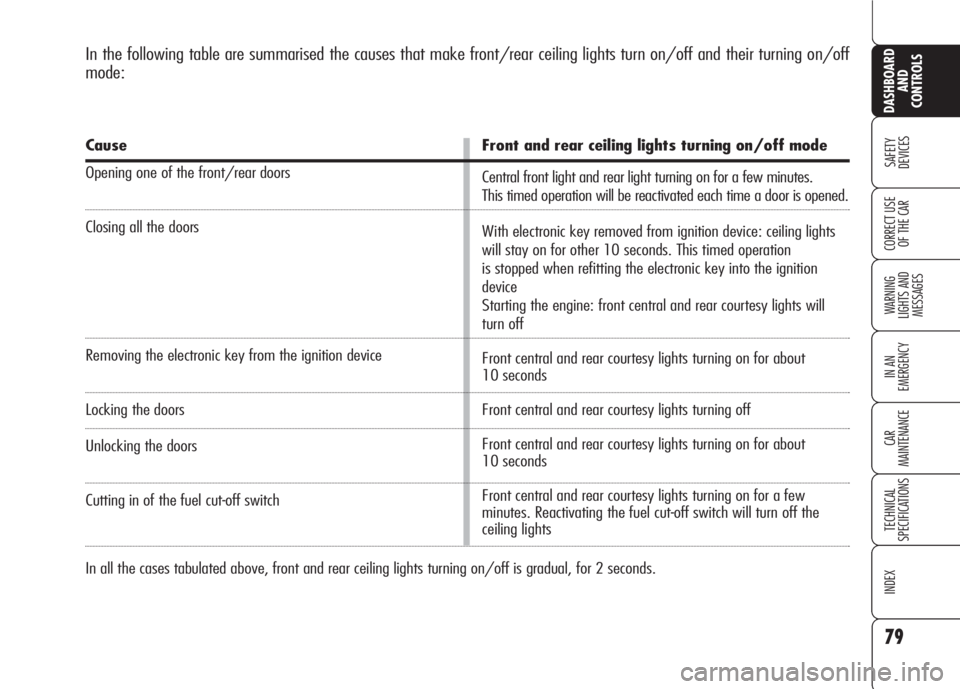
79
SAFETY
DEVICES
WARNING
LIGHTS AND
MESSAGES
IN AN
EMERGENCY
CAR
MAINTENANCE
TECHNICAL
SPECIFICATIONS
INDEX
CORRECT USE
OF THE CAR
DASHBOARD
AND
CONTROLS
In the following table are summarised the causes that make front/rear ceiling lights turn on/off and their turning on/off
mode:
Cause
Opening one of the front/rear doors
Closing all the doors
Removing the electronic key from the ignition device
Locking the doors
Unlocking the doors
Cutting in of the fuel cut-off switch
Front and rear ceiling lights turning on/off mode
Central front light and rear light turning on for a few minutes.
This timed operation will be reactivated each time a door is opened.
With electronic key removed from ignition device: ceiling lights
will stay on for other 10 seconds. This timed operation
is stopped when refitting the electronic key into the ignition
device
Starting the engine: front central and rear courtesy lights will
turn off
Front central and rear courtesy lights turning on for about
10 seconds
Front central and rear courtesy lights turning off
Front central and rear courtesy lights turning on for about
10 seconds
Front central and rear courtesy lights turning on for a few
minutes. Reactivating the fuel cut-off switch will turn off the
ceiling lights
In all the cases tabulated above, front and rear ceiling lights turning on/off is gradual, for 2 seconds.